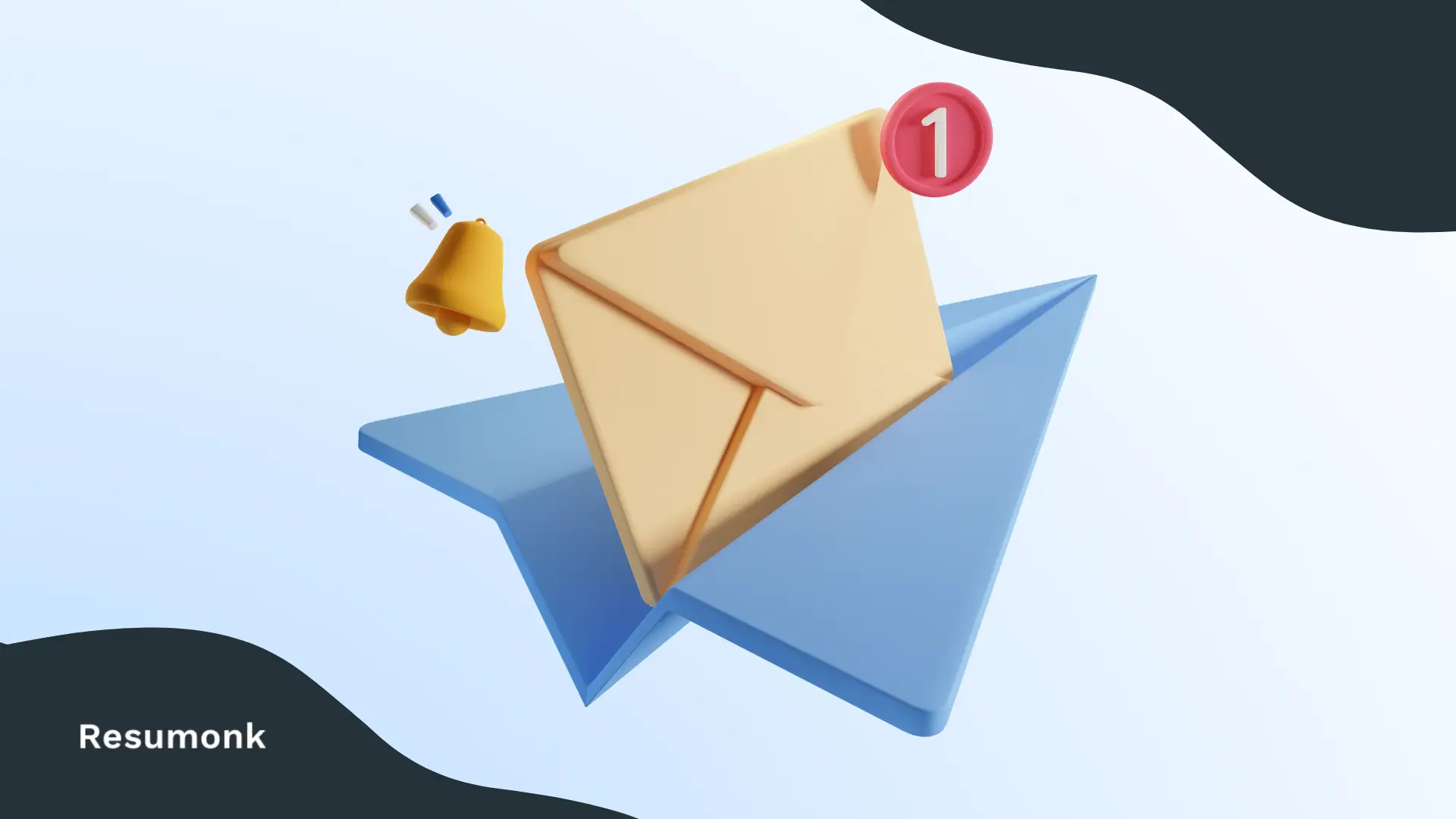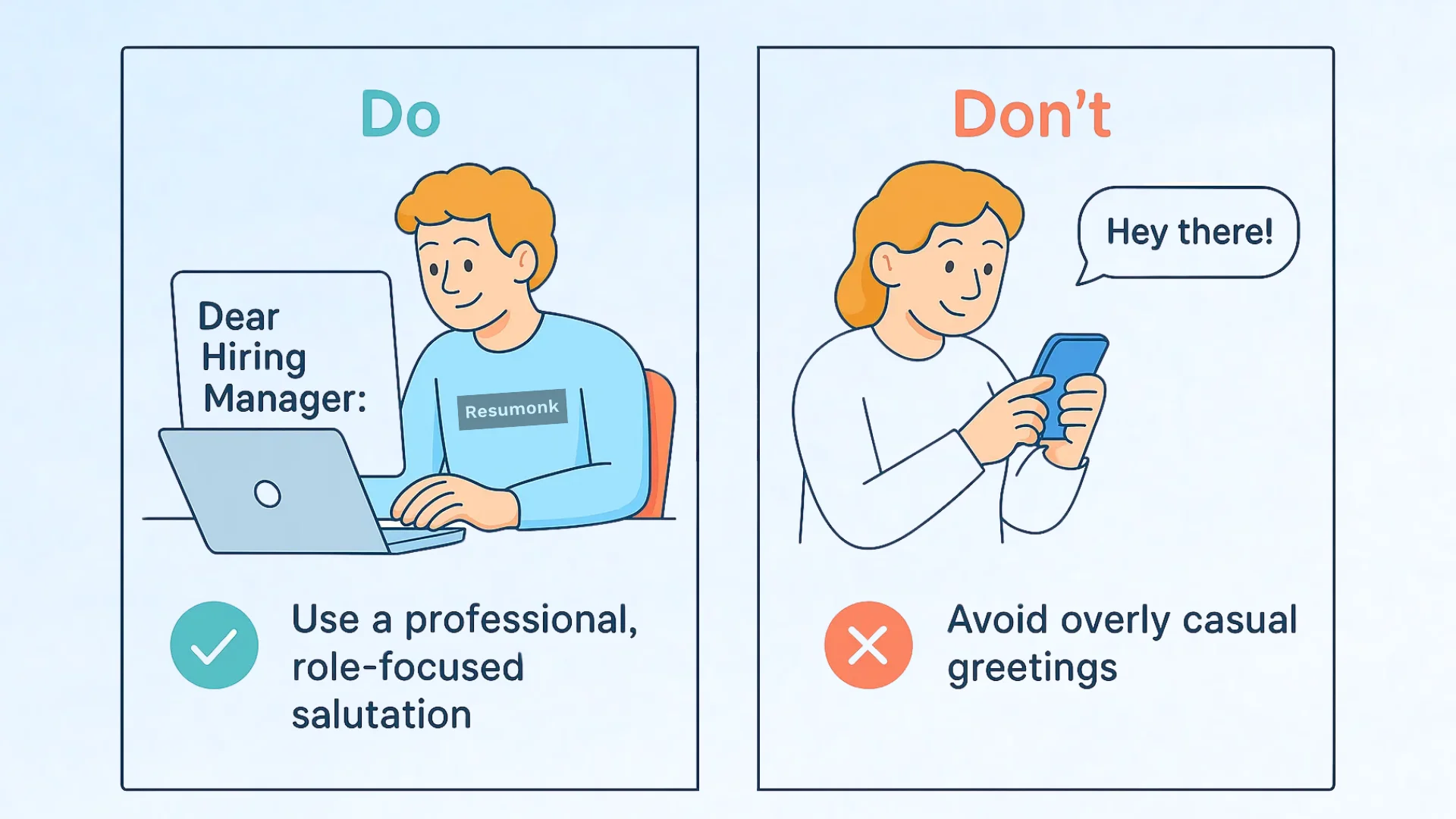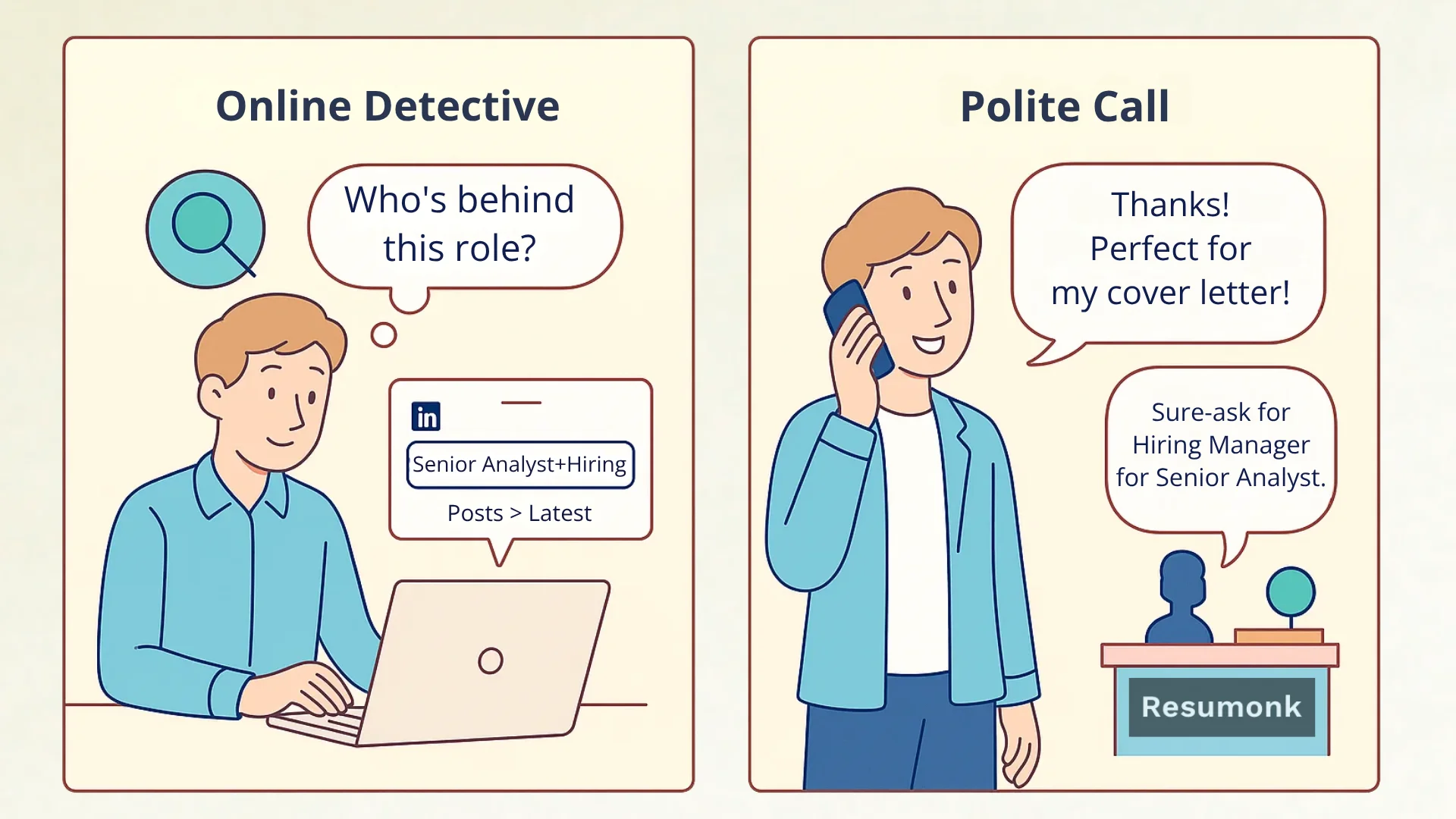
Here's a fun fact that'll make your job search anxiety spike: hiring managers can tell within seconds whether you're a thoughtful candidate or someone who hit "apply to all" after their third cup of coffee.
The culprit? That seemingly innocent line at the top of your cover letter where you're supposed to write someone's name - except you have absolutely no idea who that someone is.
You've probably stared at that blank greeting line longer than you'd care to admit, wondering if "To Whom It May Concern" makes you sound like you're filing a complaint with the postal service in 1987.
The good news is that addressing a cover letter without a name isn't just possible - it's an art form that, when done right, can actually work in your favor.
We'll walk through everything from detective-level research strategies to find the actual hiring manager, to bulletproof backup greetings that won't make recruiters cringe, plus all the formatting rules and cultural considerations that separate the pros from the "please-just-give-me-a-job" crowd.
We've seen more cover letters than coffee beans we've consumed (and that’s saying something!)
In every one-pager, the very first line explicitly says whether the candidate is detail-driven or just hitting Send-All.
A thoughtful salutation is the signal-flare of professionalism – even when you don’t yet know who sits in the corner office.
Picture a recruiter scrolling through 50+ applications before lunch.
According to a CareerBuilder survey, 10% of employers will bin a résumé that arrives without a cover letter at all – meaning the greeting is literally your first impression. Meanwhile, 65% of recruiters still read cover letters “often” or “always,” so your opener sets the tone for everyone who matters.

Get the salutation right and you jump the queue before your story even begins.
Think of personalization as the résumé equivalent of hearing your own name in a noisy airport.
Messages tailored to the recipient boost response rates by up to 40%. That finding isn’t just sales fluff; cognitive-science research shows that “conversational character” in writing triggers greater social engagement.
In practice, swapping “To whom it may concern” for a role-specific line (“Dear Product Strategy Team”) tells the reader you’ve done your homework – and humans reward homework.
Myth #1: “It doesn’t matter; nobody reads the greeting.”
Reality: generic salutations actively harm your odds. Time magazine warns that “To Whom It May Concern” signals laziness to hiring managers.
Myth #2: “Hi!” is friendly and modern.
Reality: A Preply study of 1,000 professionals found casual email greetings rank among the least-trusted openers. Translation: warmth is good, but formality pays the bills.
Corporate giants may expect “Dear Finance Hiring Manager,” while an indie game studio could smile at “Dear Art Lead.”
Yet even the most creative shops still value courtesy.
Forbes reminds applicants that a cover letter’s opening line must show “why you want this company and why you fit its goals.”
Bottom line: adapt your tone, but keep the salutation professional everywhere from Wall Street to a three-person nonprofit.
Before defaulting to a generic greeting, give yourself 20 focussed minutes to hunt down the actual decision-maker.
The detective work is simpler – and more enjoyable – than it sounds.

Start with LinkedIn because recruiters live there.
Here’s our go-to routine:
Most organisations hide gold in plain sight.
Scan the main navigation for “About Us,” “Leadership,” or “Team. ”
Many also feature department blogs where leads sign off posts – an instant clue to who will read your letter. Combine that name with the corporate email pattern you’ve seen in press releases and you’ve earned a personalised salutation.
Yes, polite detective work sometimes means calling the reception. Script the ask: “Hi there, I’m finalising my cover letter for your Senior Analyst role – may I confirm who leads that hiring process so I can address them properly?”
This small courtesy showcases both initiative and respect, traits recruiters note positively.
When phoning isn’t feasible, a brief email with the same wording and a thank-you line usually lands a name within hours. Remember, authenticity beats templates every time.
Different sectors hide contact details in different corners.
Use the cheat-sheet below:
Despite your sleuthing, sometimes the hiring manager remains a mystery. These battle-tested greetings keep things courteous without sounding robotic.
If you only remember one fallback, make it this one. Try using Dear Hiring Manager over every other generic opener. It’s gender-neutral, role-focused, and understood across industries from healthcare to hedge funds.
When the org chart is clear but the name isn’t, aim your letter at the team:
Match the department to the role advertised, then verify the official department name on the company site to avoid guesswork.
When you can infer who signs off on new hires, greet the title: “Dear Marketing Director,” “Dear Head of Sales,” or “Dear Chief Nursing Officer.”
LinkedIn search filters make it easy to confirm that such a title exists in the org – if it doesn’t, default to Dear Hiring Manager to stay safe.
Academia, government and large non-profits often recruit by committee.
In those cases, a salutation such as “Dear Hiring Committee” or “Dear Search Panel” mirrors their internal language and shows respect for collaborative decision-making.
The Chronicle of Higher Education notes that community-college panels actually expect this format when no chair is listed.
Think of a salutation as the doormat to your cover letter. If it’s frayed, dirty, or says the wrong thing, hiring managers hesitate before stepping inside.
This section highlights the greeting faux-pas that make recruiters reach for the recycle bin.
Before we dive in, imagine turning up at a 2025 tech-hub in bell-bottoms. That’s how these relics feel on modern recruiters:
“Hi,” “Hey there,” and “Hello!” are among the least-trusted e-mail openers in business settings – formality still reigns in hiring communications. Even friendly startup recruiters expect a measured “Dear Hiring Manager,” confirms Jobscan’s 2024 greeting guide Jobscan.
Canada’s Translation Bureau urges writers to drop honorifics unless invited, recommending neutral alternatives such as Dear Hiring Team.
Similarly, London’s Hackney Council outlawed “Sir/Madam” in 2024 to foster inclusivity Hackney guidance.
Rule of thumb: if you’re not 100% certain about someone’s gender or title, stay neutral and role-focused.
“Good morning” misfires when your email lands at 11 p.m. on the hiring manager’s phone.
Business-writing coaches at The Balance advise skipping time-tied phrases altogether to avoid awkward mismatches. Stick with timeless salutations and let your enthusiasm shine inside the letter.
If the greeting is the doormat, the header is the front porch. Nail the structure and recruiters will walk right in.
Follow the traditional business-letter layout recommended by Purdue OWL and The Balance:
Resumonk’s templates take care of layout and formatting, ensuring your cover letter looks just as professional as your resume.
Try it now!
Digital letters drop the employer’s mailing address and move your contact info to an e-mail signature, explains The Balance's email cover-letter guide.
Replace the formal header with a concise subject line like: Product Manager – Jordan Lee
Purdue OWL insists on a colon after formal salutations (“Dear Hiring Manager:”) Purdue business-letter rules. Grammarly notes that some U.S. companies accept a comma in emails, but the colon remains safest for print.
Cap every word in a professional title (Dear Marketing Director) to show respect.
Etiquette shifts by postcode. Prospects UK suggests “Dear Sir/Madam” only after exhausting all research methods.
Australian recruiter Robert Walters recommends first-name greetings if the hiring manager’s name is known, otherwise default to role-based lines.
Canada’s public-service FAQs allow addressing the “human resources team” when bilingual postings list no contact.
In the U.S., Indeed stresses “Dear Hiring Manager” as the safest all-purpose fallback.
Culture shapes courtesy. A greeting that feels respectful in Boston may sound stiff in Brisbane.
Use these regional pointers to fine-tune your opener.
Most U.S. recruiters still expect Dear Hiring Manager when the name is unknown.
Formality trends slightly higher on the East Coast’s corporate hubs, while West-Coast tech companies tolerate greetings like “Dear Product Team.” Regardless of geography, generic “To Whom It May Concern” is widely frowned upon.
Canada’s bilingual environment means roles in Quebec may expect a French salutation such as “Madame, Monsieur,” or an English/French combo (refer to the Government of Canada language guide)
When in doubt, address the “Human Resources Team,” a framing the CSIS careers site explicitly approves in their FAQs.
UK career advisers still suggest “Dear Sir/Madam,” but only after diligent research; many hiring teams now prefer role-based greetings. Across the Commonwealth, inclusivity drives similar shifts - as we witnessed with Hackney Council’s 2024 ban on “Sir/Madam” in London.
Australian recruiters echo the same lean toward first names when possible.
Applying to a global firm?
Research the HQ location’s norms first, then check local branch culture. The Balance recommends adapting your greeting to the reader’s locale, not your own.
If multiple regions are involved, a neutral “Dear Hiring Committee” keeps everyone included.
Once you’ve mastered the basic greetings, it’s time to fine-tune your salutation so it vibes with the company’s size, sector and hiring culture.
Here’s how we suggest tailoring the opener for four very different worlds.
Imagine walking into a co-working loft in sneakers versus a marble-floored HQ in wingtips.
Your greeting should switch shoes too. Use the cheat sheet below to keep your tone on-brand:
Federal postings often list a program or branch rather than a single person.
Addressing “Dear Selection Panel” is perfectly acceptable, confirms Indeed’s government-job cover-letter guide.
In academia, The Chronicle of Higher Education recommends “Dear Search Committee” when no chair is named, emphasising that committees read letters collectively.
Sometimes, there can be exceptions to being too formal. If you open with “Dear Storytelling Squad” for a boutique ad agency - you're still likely to get the interview - if their culture is more youthful.
The key is balancing flair with respect. A 2025 University of Cincinnati career guide notes that personalised hooks lift response rates by 38%.
Just keep colloquialisms in check; even the hippest studio will side-eye “Hey folks!”.
If you discover the hiring manager’s name after sending your application, mirror it in your follow-up email while referencing your earlier generic greeting.
Here's an example “Dear Ms. Patel - last week I applied with the salutation ‘Dear Hiring Manager’ and wanted to personalise my thanks now that I have your name.”
Consistency shows you pay attention without pretending the first salutation never happened.
Real-world job ads rarely hand you a neat contact card.
Below are the puzzles we see most often - and the fixes that keep your salutation polished.
Scenario 1: The ad lists only “Apply via portal.”
Scan LinkedIn for the department head, then open with “Dear Engineering Department” if a name stays hidden.
(LinkedIn reminds applicants against “To Whom It May Concern” back this approach.)
Scenario 2: Government bid with a requisition number.
Use “Dear Hiring Committee” and reference the requisition in the first line - as suggested by Indeed Government Guide.
Scenario 3: Startup job board ad signed “ - The Team.” Default to “Dear Product Team.”
(Formality still matters; TIME warns lazy greetings doom first impressions.)
When three directors share hiring duties, group them: “Dear Search Panel.”
This neutral phrase is endorsed in Work It Daily’s 2025 quick-tip.
If individual names are listed, rank them by seniority - “Dear Dr. Chen, Ms. Ortiz and Mr. Jones” - to mirror academic etiquette.
Recruiter-posted roles blur the addressee line.
Industry norm is to greet the recruiter by name (“Dear Ms. Harris”) because they pre-screen candidates, a point reinforced in Indeed’s “Dear Hiring Manager” FAQ.
If confidentiality masks the client, end your first paragraph with, “I appreciate that the end employer remains confidential at this stage.”
Breathed a sigh and spotted a typo later? Send a brief follow-up note within 24 hours:
“I noticed I mistyped your title in my earlier letter - my apologies for the oversight.”
.webp)
Career advisors at Work It Daily stress that prompt, polite correction often improves perception by showing accountability.
For applications already in review, pair your correction with an attachment labelled “Updated Cover Letter” as advised by Indeed’s follow-up email guide.
The art of addressing a cover letter without a name is all about showing respect, professionalism, and genuine interest - even when you're working with limited information. Here are the essential strategies that will make your greeting stand out for all the right reasons:
The magic of mastering cover letter greetings lies in understanding that even without a name, you can still create a personal connection. When you combine thoughtful research with professional alternatives and proper formatting, you transform a potential weakness into a strength that sets you apart from the competition.
Ready to elevate your cover letter game and make every greeting count?
Try Resumonk now to get beautiful templates and AI-powered guidance can help you craft cover letters that open doors, whether you know the hiring manager's name or not.